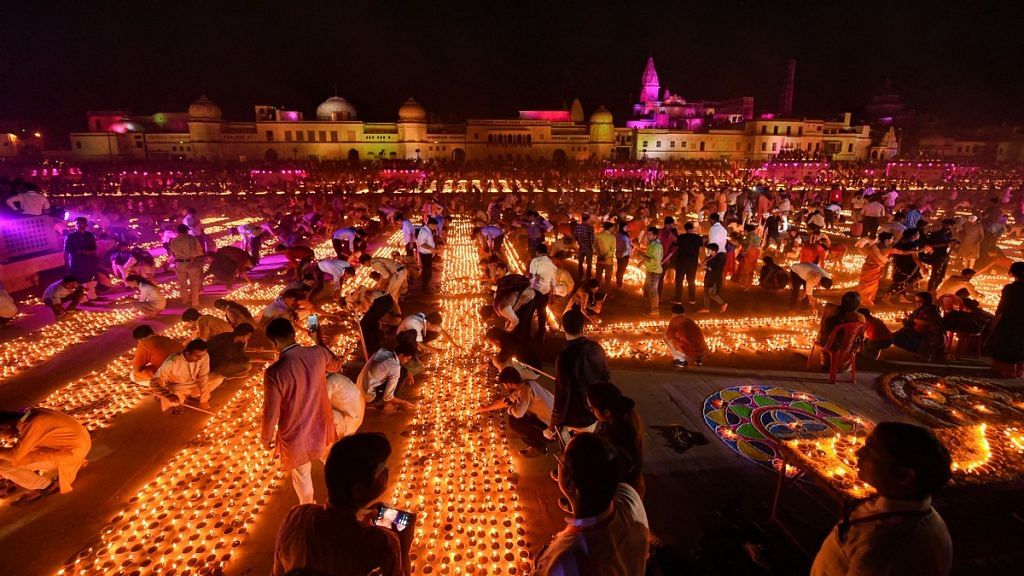New Delhi: The Uttar Pradesh government is choosing tradition over expert advice and pushing ahead with the millennia-old Ayodhya Ram Navami Mela despite the coronavirus pandemic. The mela (fair), which draws lakhs of pilgrims from across the country, will be held from 25 March to 2 April.
While the Ayodhya chief medical officer has raised concerns about the implications of a huge crowd gathering at one place right now, the administration has brushed them aside. This, despite the Adityanath administration issuing advisories against mass gatherings, including for Holi, with the Board of Cricket Control for India (BCCI) also calling off the India-South Africa ODI matches scheduled to be held in Lucknow and Kolkata this month.
The mela this year has assumed added significance because it’s the first one since the Supreme Court cleared the way for the construction of a Ram temple in Ayodhya after a decades-old court battle between Hindu and Muslim parties over the ownership of the plot in question.
The fair will start with a ceremony where the idol of the reigning deity, infant Ram or Ram Lalla, will be shifted from its makeshift tent to a massive fibre-glass structure amid preparations for the construction of a temple in his honour. This ceremony will be led by the Ram Janmabhoomi Teertha Kshetra Trust, which is overseeing the temple construction, with the Vishva Hindu Parishad (VHP) planning a concurrent nationwide programme to celebrate the occasion.
The VHP has discouraged mass mobilisation for the programme, but will go ahead with its plans to place Ram idols or photos in 2.75 lakh villages and perform puja to commemorate the November 2019 Supreme Court judgment.
Also Read: New paper-based test developed by MIT researchers claims to detect coronavirus in 30 mins
A big ceremony for Ram
On 25 March, the first day of the Chaitra (first month of Hindu calendar) Navratri, the Ram idol will be established inside a bullet-proof, water-proof fibre glass structure that will be 21 feet in length and 15 feet in width.
It was brought to Ayodhya Sunday. As the idol is placed there, Uttar Pradesh Chief Minister Yogi Adityanath will perform the first aarti the same day.
The Ram Navami Mela, a traditional annual event in Ayodhya, will kick off the same day.
The mela sees lakhs of devotees converge on Ayodhya to offer prayers at different temples. On the night of Ram Navami, the birth of Ram is celebrated at decorated temples. Devotees take a dip in the Saryu and aarti and puja follow.
VHP president Alok Kumar told ThePrint that postponing the event was not an option.
“The shifting of Bhagwan Ram from the makeshift tent to the chabutara (platform) is long due. It’s a shubh muhurat on 24-25 March and the event can’t be deferred,” he said.
“The trust (which includes a VHP member) decided in the first meeting to carry out this programme… Lord Ram’s been in a tent for the last 28 years… Before the construction of the temple starts, in the shubh muhurat, this ceremony will take place.”
Speaking about the nationwide programme planned by the VHP, Kumar said, “We have planned a grand Ram mahotsav from 25 March until Hanuman Jayanti, which falls on 8 April to felicitate the Ram temple judgment.
“In 2.75 lakh villages, a Ram idol or photo will be established and puja performed, but due to the coronavirus threat, we have advised that big mass programmes be avoided on this duration.”
Also Read: Why doctors in Italy are letting some coronavirus patients die to save others
CMO has flagged concerns
Ayodhya chief medical officer (CMO) Ghyanshyam Singh has been flagging concerns about going ahead with the mela, wondering how the lakhs of attendees would be screened and protected from infection.
On Monday, the CMO cited the chief minister’s advice against large gatherings to say they didn’t have “infrastructure to screen and hand out masks to 5 lakh people”.
“I have advised the district administration to cancel the Ram Navami mela this time,” he said.
However, Ayodhya district magistrate Anuj Kumar Jha, a member of the temple construction committee, snubbed the CMO.
“This is part of the tradition and we will take precautions but there is no plan to cancel the Ram Navami mela,” Jha added. “The district administration has been making preparations for the past one month.”
The VHP head for Ayodhya district, Sharad Sharma, told ThePrint that Ram Navami was special for devotees. “This is part of our faith and, every year, Ram Navami celebration is held. But more people will take a dip in the Saryu this year on Ram Navami… There is no question of cancelling the mela and Ram mahotsav.”
BJP leader Ved Prakash Gupta, the local MLA, said it was the “duty of the district administration to distribute masks to protect devotees… but the option of cancelling Ram Navami mela is against tradition and faith”.
Temples across India discourage gatherings
In other parts of the country, the coronavirus pandemic led temples to issue a series of steps and advisories Sunday to keep devotees safe.
The chief executive officer of the Shirdi Sai Mandir Sunday has appealed to devotees to stay at home, while the Vaishno Devi Shrine Board has echoed the claim, asking foreigners and NRIs in particular to not visit at all for 26 days.
On Monday, the Siddhivinayak trust decided to shut down Mumbai’s famous Siddhivinayak temple in view of the coronavirus outbreak.
The Ministry of Home Affairs (MHA) has suspended the Kartarpur Corridor pilgrimage, while the Swami Narayan Temple has canceled big events worldwide. The Datia-based Pitambara Peeth has also cancelled large gatherings of devotees.
Also Read: How coronavirus spread in India — 39 of the first 50 patients came from Italy, Iran, China
